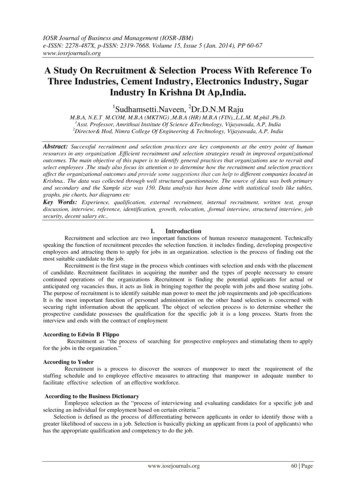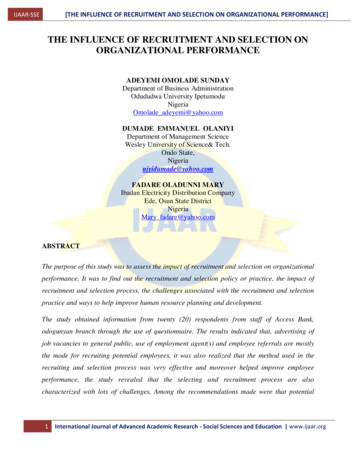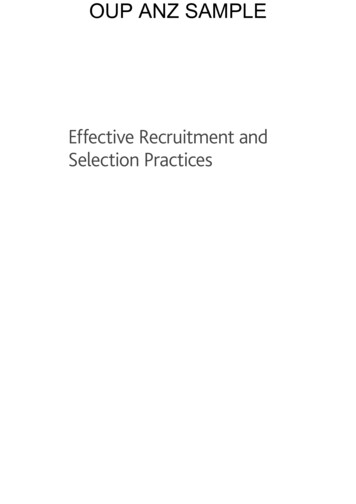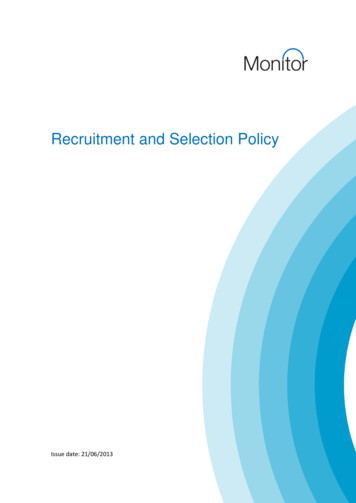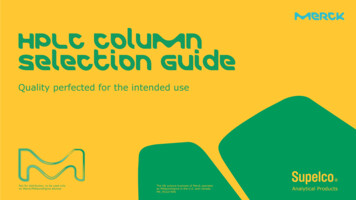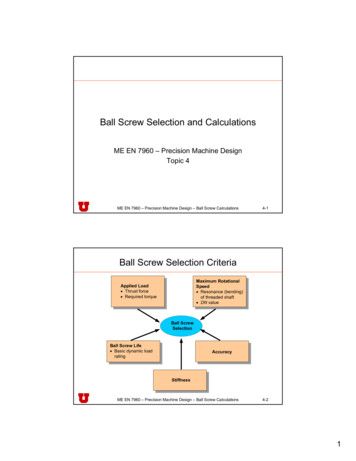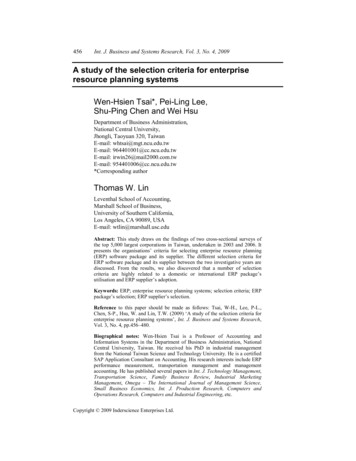
Transcription
456Int. J. Business and Systems Research, Vol. 3, No. 4, 2009A study of the selection criteria for enterpriseresource planning systemsWen-Hsien Tsai*, Pei-Ling Lee,Shu-Ping Chen and Wei HsuDepartment of Business Administration,National Central University,Jhongli, Taoyuan 320, TaiwanE-mail: whtsai@mgt.ncu.edu.twE-mail: 964401001@cc.ncu.edu.twE-mail: irwin26@mail2000.com.twE-mail: 954401006@cc.ncu.edu.tw*Corresponding authorThomas W. LinLeventhal School of Accounting,Marshall School of Business,University of Southern California,Los Angeles, CA 90089, USAE-mail: wtlin@marshall.usc.eduAbstract: This study draws on the findings of two cross-sectional surveys ofthe top 5,000 largest corporations in Taiwan, undertaken in 2003 and 2006. Itpresents the organisations’ criteria for selecting enterprise resource planning(ERP) software package and its supplier. The different selection criteria forERP software package and its supplier between the two investigative years arediscussed. From the results, we also discovered that a number of selectioncriteria are highly related to a domestic or international ERP package’sutilisation and ERP supplier’s adoption.Keywords: ERP; enterprise resource planning systems; selection criteria; ERPpackage’s selection; ERP supplier’s selection.Reference to this paper should be made as follows: Tsai, W-H., Lee, P-L.,Chen, S-P., Hsu, W. and Lin, T.W. (2009) ‘A study of the selection criteria forenterprise resource planning systems’, Int. J. Business and Systems Research,Vol. 3, No. 4, pp.456–480.Biographical notes: Wen-Hsien Tsai is a Professor of Accounting andInformation Systems in the Department of Business Administration, NationalCentral University, Taiwan. He received his PhD in industrial managementfrom the National Taiwan Science and Technology University. He is a certifiedSAP Application Consultant on Accounting. His research interests include ERPperformance measurement, transportation management and managementaccounting. He has published several papers in Int. J. Technology Management,Transportation Science, Family Business Review, Industrial MarketingManagement, Omega – The International Journal of Management Science,Small Business Economics, Int. J. Production Research, Computers andOperations Research, Computers and Industrial Engineering, etc.Copyright 2009 Inderscience Enterprises Ltd.
A study of the selection criteria for ERP systems457Pei-Ling Lee is a PhD student in Financial Management at the Department ofBusiness Administration, National Central University, Taiwan. She hascompleted her MSc in Finance and Investment Management at the Universityof Aberdeen in Scotland in the UK and her BA in Industrial Engineering atChun-Yuan Christian University in Taiwan, ROC. Her current researchinterests include ERP implementation and management, ERP performancemeasurement, activity based costing and entrepreneurial policy in SME.Shu-Ping Chen is a PhD candidate in Financial Management at the Departmentof Business Administration, National Central University, Taiwan. She has doneMBA in Management Sciences from Aletheia University. Her current researchinterests include ERP performance measurement, project management andcorporate finance.Wei Hsu is a PhD student in Financial Management at the Department ofBusiness Administration, National Central University, Taiwan. She has doneher MA at the Department of Economics, the State University of New York atBuffalo. Her research interests are focused on enterprise resource planningperformance measure, multi-criteria decision making, management accountingand financial management.Thomas W. Lin is a Professor of Accounting in the Marshall School ofBusiness, University of Southern California, USA. He received his PhD inaccounting from the Ohio State University, MS in accounting and informationsystems from UCLA, and BA in business administration from National TaiwanUniversity. His research interests include management accounting andmanagement control systems. He has published papers in the AccountingReview, Journal of Management Accounting Research, Journal of InformationSystems, Int. J. Management, etc.1IntroductionIn order to stay competitive in a dramatically changing business environment,organisations have to enhance their business practices and operational procedures throughinformation technology such as enterprise resource planning (ERP) (e.g. Al-Mashari,2003; Rao, 2000; Somers and Nelson, 2004; Tsai et al., 2007b), e-commerce (e.g. Aciaret al., 2007; Ahmed et al., 2007; Chuang et al., 2007), e-finance (e.g. Tsai et al., 2006),Knowledge management (e.g. King, 2007), business process reengineering (e.g. Leeet al., 2007), etc. Leem and Kim (2002) pointed out that information technology is animportant weapon in the fight to improve and keep an enterprise’s competitive edge in anever-changing business environment. According to Gupta (2000), he considers that theERP system is an integrated information technology that uses common databases andconsistent cross-functional information flow which enables organisations to integrateinformation from various departments. Moreover, Hong and Kim (2002) found that thesedemands have prompted more and more firms to shift their information technologystrategies from developing in-house information systems to purchase applicationsoftware, like ERP systems, to generate synergies and enchase operating efficiency.Wallace and Kremzar (2001) also mentioned that operating a business in a rapidlychanging and highly competitive environment is the primary purpose of implementing anERP system. Although implementing an ERP system may be costly and time-consuming,
458W-H. Tsai et al.its benefits are worthwhile. Therefore, ERP systems can be considered as critical toolsthat can enhance business operations.Many organisations tend to purchase ERP packages to shorten the ERPimplementation cycle time due to a lack of professional expertise and experience withinthe organisation instead of developing ERP systems in-house. However, not all of theERP packages in the market can meet all of the requirements and anticipations of everyorganisation due to organisations’ different scales, properties, strategies and goals.Therefore, management teams have to select suitable packages which most closely meettheir needs.Although different hardware platforms, databases, languages and operation systemsare provided or recommended by ERP suppliers, a number of ERP software is onlycompatible with some organisations’ databases and operation systems. Thus, beforeimplementing ERP packages, organisations should first conduct a requirements analysisto determine what issues need to be solved and then select the best suitable ERP package.Through careful planning and selection of the right ERP system, an organisation mayexpect to gain noteworthy advantages.2Literature reviewAccording to Jacobs and Weston Jr. (2007), a key to ERP is the way in which users cantailor the application so it is intrinsically easy to use. ERP systems can reduce cycle time,accelerate information distribution, improve financial management, lay the groundworkfor e-commerce and make tacit knowledge explicit provided they are properlyimplemented in a business organisation (Davenport, 2000). In addition, ERP systems arecapable of reshaping business structures thanks to their ability to solve the challengescreated by portfolios of supposedly disconnected and uncoordinated business applications(Davenport, 1998). Moreover, ERP integrates application programmes for a range ofbusiness functions – including sales, accounting and manufacturing – using a commondatabase that serves as the integrating mechanism (Olhager and Selldin, 2003). Thus,ERP incorporates logistic, capital and information via an information technology systemso that management teams can obtain firsthand information about a business’ operations.Furthermore, ERP can provide suggestions for management teams making decisions andassist them in figuring out an optimal solution. However, ERP system implementationcan be both expensive and time-consuming (e.g. Abdinnour-Helm et al., 2003; Kumaret al., 2003). Therefore, choosing a suitable ERP package necessitates considering thedegree to which the configured ERP system matches with users’ working style andpractice and the extent of congruence between what is provided by the ERP system anduser task requirements. Further, if the right ERP solution is selected, it can be anexcellent decision support tool that will be a gruelling process for companies and providea competitive advantage.A large amount of literature concentrating on ERP issues has been published (Estevesand Pastor, 2001). For example, numerous literature regarding ERP implementation havebeen put forward to illustrate an extensive set of risk factors, management issues andcritical success factors for ERP implementation projects (e.g. Al-Mashari et al., 2003;Hong and Kim, 2001; Holland et al., 1999; Nah and Lau, 2001; Nandhakumar et al.,2003; Sumner, 2000; Tsai et al., 2005; Umble et al., 2003; Zhang et al., 2005). Manystudies have analysed the different implementation strategies between the different
A study of the selection criteria for ERP systems459approaches such as integral planning and big-bang/phased implementation approach andstepwise planning and phased implementation approach (e.g. Holland et al., 1999;Lozinsky and Wahl, 1998; Ross, 1998; Tsai et al., 2007a). Moreover, according toMarius and Ashok (1996), it is hypothesised that packaged software implementationsuccess is positively associated with the degree of software fit with user organisation andthe degree of supplier fit with user organisation, respectively. Even there are severalempirical studies in ERP field; however, empirical evidence of ERP package and itssupplier’s selection criteria between two different investigative years for ERP system andits supplier in Taiwan is relatively rare.According to some researchers, selecting the suitable solution is a critical successfactor for ERP system success. The perceived characteristics of the product play a vitalrole in the final decision to launch using a new product while companies considerpurchasing that new product. Among the number of the alternatives, organisations usevarious criteria for determining the suitable ERP solution. Hecht (1997) presents sixmajor criteria, which are functionality, technical architecture, cost, service and support,ability to execute, and vision, for selection and evaluation process. Edward and Stefan(2001) investigated differences in characteristics of the ERP system selection processbetween midsize and large organisations. They used 29 different ERP selection criteriaand determined only 12 criteria that have strong relationship to organisation size. Thecriteria for selection of a particular ERP system show different priorities related toorganisational size. Organisational flexibility, extra organisational ties with customersand suppliers and internationality are more important for the bigger. Cost and adaptabilityare more important criteria in selection process for smaller companies. Somers andNelson (2001) stressed that the choice of the package involves important decisionsrelated to budgets, timeframes, goals and deliverables that will shape the entire projects.Yvonne et al. (2000) did an empirical information research to examined issues of theselection criteria used by European midsize companies for investing ERP systems. Theyused following six selection criteria: lowest cost, user-friendliness, fit with businessprocedures, scalability, support and training. Their results show the most importantcriterion used in selecting an information system is the best fit with the current businessprocedures. In Kumar et al.’s (2003) research, functionality, system reliability and fitwith parent/allied organisation systems are determined as the three most importantcriteria. Moreover, 17 selection criterion, fit with parent organisation systems,cross-module integration, compatibility with other systems, references of the vender,vision, functionally, system reliability, consultancy, technical aspect, implementationtime, methodology of the software, market position of vendor, ease of customisation,better fit with organisational structure, service and support, cost and domain knowledgeof the vendor, are selected as determining the ERP packaged-selecting criteria byBirdogan and Kemal (2005).Supplier support is an important factor for ERP systems implementation and oftenincludes extended technical assistance, emergency maintenance, updates, serviceresponsiveness, solutions providing, design, customisation support and user training(e.g. Eric et al., 2008; Ramayah et al., 2007; Remus, 2007; Somers and Nelson, 2001;Zhang et al., 2005). Moreover, according to Themistocleous et al. (2001), mostcompanies face technical or other problems during installation, implementation or afterimplementation period. Integration with existing systems, customisation and security arethe most serious problems for the companies. To deal with these problems, companiesneed support from suppliers both in terms of information technology expertise and
460W-H. Tsai et al.domain knowledge (Rao, 2000). Yvonne et al. (2000) also did an empirical informationresearch to examined issues of the selection criteria used by European midsize companiesfor choosing an ERP supplier. They use the following eight selection criteria:functionality product, quality product, implementation speed, interface other systems,price, market leadership, corporate image and international orientation. They foundcompanies predominantly value the functionality and quality of the products and servicesfor evaluating ERP suppliers. Verville and Halingten (2002) determined three distincttypes of criteria for evaluation: supplier, functionality and technical. The supplierevaluation criteria in their study include size, financial stability and reputation, etc.There is an increasing evidence showing that failing to adapt ERP packages to fitrequirements, organisations practices and natural culture leads to expensive and lateprojects and to low user satisfaction (e.g. Krumbholz and Maiden, 2001; Soh et al.,2000). Moreover, Chwen et al. (2004) found that language difference affects theimplementation practices in both technical and managerial aspects. Furthermore, theyalso discovered that while technical problems were relatively easier to resolve,communication barriers resulting from language differences were far more difficult toovercome. Moreover, the results in the study of Tsai et al. (2005) indicated that the ERPpackage market in Taiwan seems to be dominated by local suppliers. In Taiwan, smalland medium-sized enterprises (SMEs) accounted for 97.83% and 97.77% of totalenterprises in 2003 and 2006, respectively (sources by: SME administration, Ministry ofEconomic Affairs). While organisations in Taiwan are much smaller than those in Europeand North America, the budget for implementing ERP packages might be relative limited.Implementing an international ERP package is much more expensive than implementinga domestic one. Therefore, this study infers that not all Taiwanese SMEs could afford topurchase an international ERP package. Thus, we wonder whether other influences of theERP package’s selection criteria would determine to adopt a domestic or internationalERP package.3MethodologyQuestionnaire surveys regarding the implementation of ERP in Taiwan were firstconducted in 2003. According to Elisabeth et al. (2003), they had been estimated that thepayback period for an ERP system typically ranges from one to three years afterimplementation; moreover, Mary et al. (2006) also discovered that the firstimplementation in each of the organisations occurred two to three years after projectbegan. As a result, the questionnaires were distributed out again in three years later,which is 2006. These two surveys examine the ERP implementation experiences of thetop 5,000 largest corporations in Taiwan, in order to explore the status of ERPimplementation. The questionnaires focus on five areas: the characteristics ofERP implementation, ERP implementation status, motivation and evaluation ofpre-implementation process, implementation experience and ERP system configuration,as well as benefits of ERP system and future directions. In this study, we use part ofsurvey data in the questionnaire to examine whether there were any significantdifferences among the organisations regarding their selection criteria between 2003 and2006. This section first describes the source of the investigative samples and then statesthe hypotheses in F2 test for independence.
A study of the selection criteria for ERP systems4613.1 Sample and data collection2003 and 2006 questionnaires were distributed to ranking on the 2001 and 2004 list oftop 5000 largest corporations in Taiwan which include the manufacturing industry andservice industry. A total of 3957 and 4300 questionnaires were sent to organisations inthe years of 2003 and 2006 with usable responses of 657 and 620 received, respectively.After deleting missing responses and unusable ones, the total usable data have beenreceived for response rates of 16.6% in 2003 and 14.4% in 2006. It is worth mentionedthat our data collection effort reflects the typically low responses that are commonly seenfor information system studies in the field and for our surveys targeting midlevel andsenior employees in organisation (Ifinedo, 2006). The response rate is 17% forBernroider and Koch’s (2001) research that also aim to identify the important ERPsoftware selection criteria for Austrian companies and 3.9% for Rao’s (2000) research. Inthis study, only organisations with prior experience of implementing ERP systems wereselected as our investigative sample. Therefore, the final investigative samples included224 out of 657 received questionnaires in 2003 and 249 out of 620 in 2006.According to a set of evaluation criteria based on the extensive literature review(e.g. Edward and Stefan, 2001; Kumar et al., 2003; Somers and Nelson, 2001;Teltumbde, 2000; Verville and Halingten, 2002; Yvonne et al., 2000) and theconsideration of the characteristics and environment of ERP systems, 20 and 9 selectioncriteria for the ERP package and supplier were identified, respectively. To ensure datavalidity and reliability of the survey instrument, an iterative process of personal interviewwith eight knowledgeable individuals (i.e. two information system faculty, two ERPsupplier, two ERP consultant and two managerial level user) were conducted to modifythe questionnaire before sending it out and their comments also helped us improve itsquality. The questionnaires were sent to the ERP project managers and senior projectteam members of selected companies. In the questionnaire, YES/NO selections were usedto see if the selection criteria were taken into account for selecting their ERP package orERP supplier.Tables 1 and 2 summarise the basic characteristics of the responding firms in 2003and 2006, respectively. The sample involved with 19 foreign firms, 17 domestic-foreignjoint venture and 188 domestic companies in 2003 in Taiwan and 7 foreign firms,18 domestic-foreign joint venture and 138 domestic companies in 2006. The samplecontained 146 companies (65.18% of 224) with fewer than 300 employees in 2003 and159 (63.86% of 249) in 2006. A total of 191 companies (85.27% of 224) were withannual revenues below NT 5 billion in 2003 and 205 companies (82.33% of 249) in2006. The sample also include 207 companies (92.41% of 224) with capital amount lessthan NT 5000 million in 2003 and 230 companies (92.37% of 249) in 2006. There were159 companies (62.5% of 224) with more than five years ERP experience in 2003 and 99companies (39.76% of 249) in 2006. Among these organisations, approximately 174companies (77.68% of 224) are manufacturers and 50 are members (22.32% of 224) inservice industr
software, like ERP systems, to generate synergies and enchase operating efficiency. Wallace and Kremzar (2001) also mentioned that operating a business in a rapidly changing and highly competitive environment is the primary purpose of implementing an ERP system. Although imp

